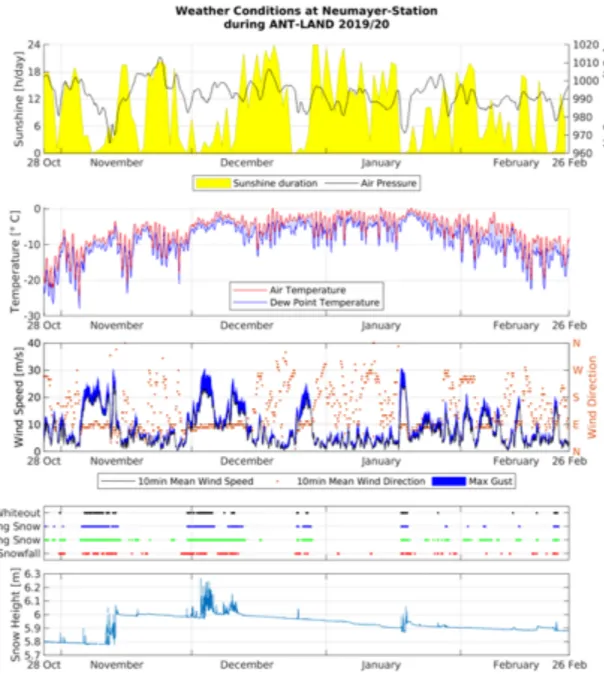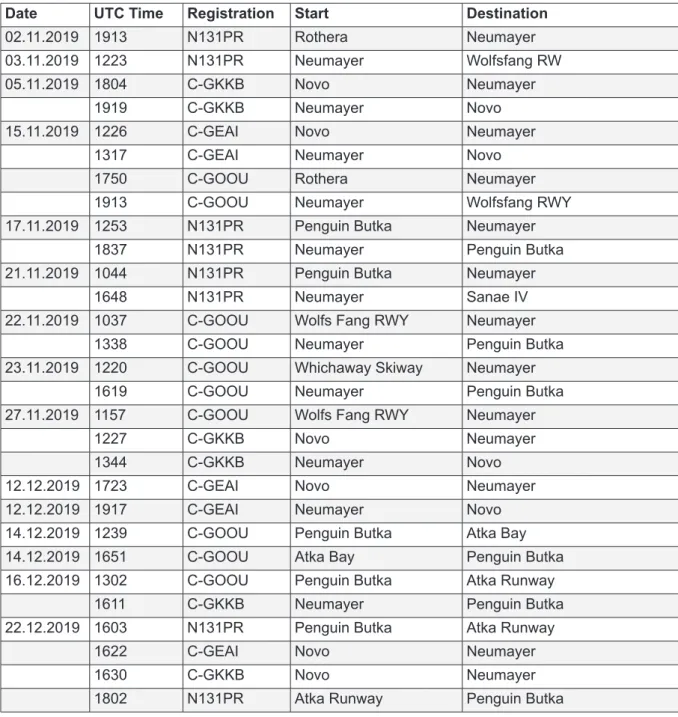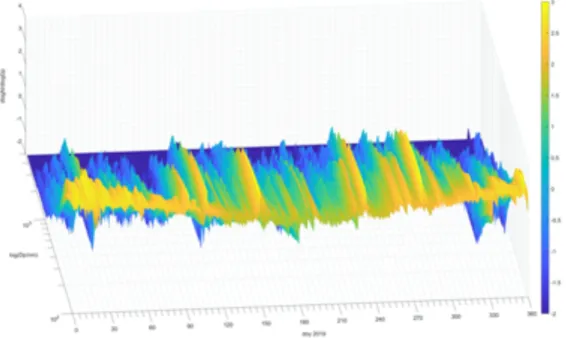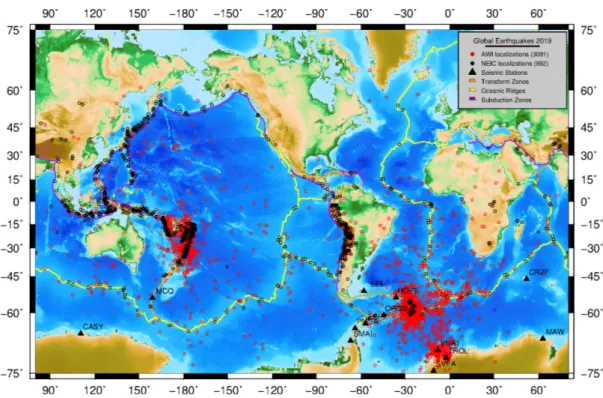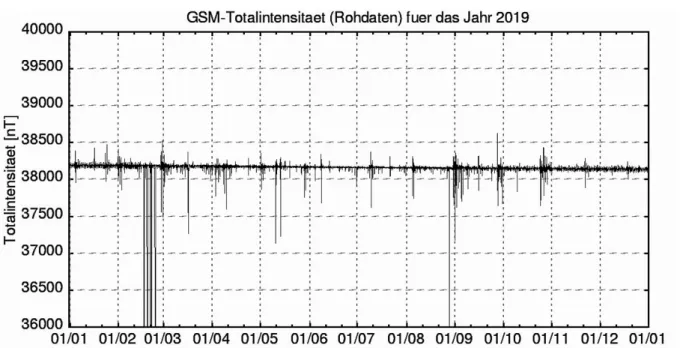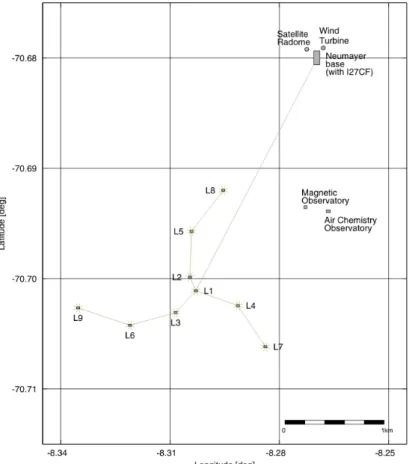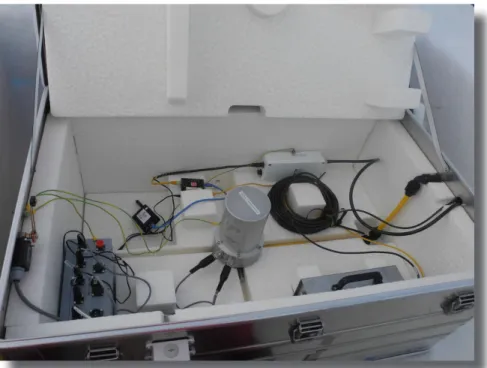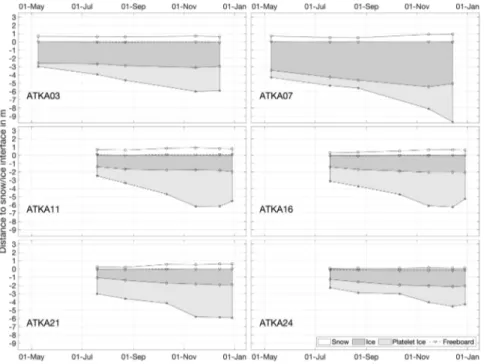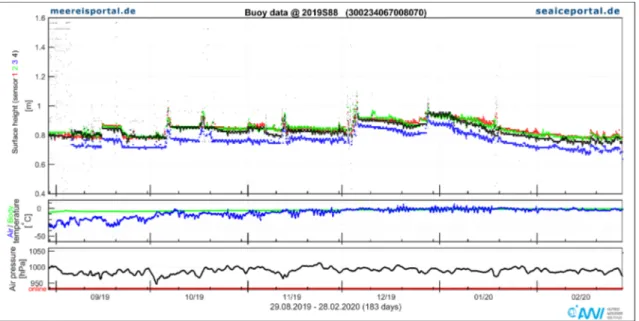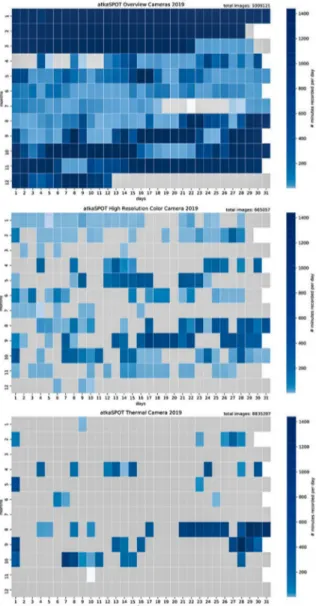Expeditions to Antarctica: ANT-Land 2019/20 Neumayer Station III, Kohnen Station, Flight Operations and Field Campaigns
Edited by
Tanja Fromm, Constance Oberdieck, Thomas Matz, Christine Wesche
with contributions of the participants
Berichte
zur Polar- und Meeresforschung
Reports on Polar and Marine Research
745
2020
Die Berichte zur Polar- und Meeresforschung werden vom Alfred-Wegener-Institut, Helmholtz-Zentrum für Polar- und Meeresforschung (AWI) in Bremerhaven, Deutschland, in Fortsetzung der vormaligen Berichte zur Polarforschung herausgegeben. Sie erscheinen in unregelmäßiger Abfolge.
Die Berichte zur Polar- und Meeresforschung ent- halten Darstellungen und Ergebnisse der vom AWI selbst oder mit seiner Unterstützung durchgeführten Forschungsarbeiten in den Polargebieten und in den Meeren.
Die Publikationen umfassen Expeditionsberichte der vom AWI betriebenen Schiffe, Flugzeuge und Statio- nen, Forschungsergebnisse (inkl. Dissertationen) des Instituts und des Archivs für deutsche Polarforschung, sowie Abstracts und Proceedings von nationalen und internationalen Tagungen und Workshops des AWI.
Die Beiträge geben nicht notwendigerweise die Auf- fassung des AWI wider.
The Reports on Polar and Marine Research are issued by the Alfred Wegener Institute, Helmholtz Centre for Polar and Marine Research (AWI) in Bremerhaven, Germany, succeeding the former Reports on Polar Research. They are published at irregular intervals.
The Reports on Polar and Marine Research contain presentations and results of research activities in polar regions and in the seas either carried out by the AWI or with its support.
Publications comprise expedition reports of the ships, aircrafts, and stations operated by the AWI, research results (incl. dissertations) of the Institute and the Archiv für deutsche Polarforschung, as well as abstracts and proceedings of national and international conferences and workshops of the AWI.
The papers contained in the Reports do not necessarily reflect the opinion of the AWI.
Herausgeber
Dr. Horst Bornemann
Redaktionelle Bearbeitung und Layout Birgit Reimann
Editor
Dr. Horst Bornemann Editorial editing and layout Birgit Reimann
Alfred-Wegener-Institut
Helmholtz-Zentrum für Polar- und Meeresforschung Am Handelshafen 12
27570 Bremerhaven Germany
www.awi.de www.awi.de/reports
Titel: Geodätische GNSS-Messungen auf dem Nunatak Monsrudnabben, Heimefrontfjella, Ostantarktis.
Foto: Eric Buchta, TU Dresden.
Title: Geodetic GNSS-measurements on Monsrudnabben Nunatak, Heimefrontfjella, East Antarctica, Photo: Eric Buchta, TU Dresden.
Alfred-Wegener-Institut
Helmholtz-Zentrum für Polar- und Meeresforschung Am Handelshafen 12
27570 Bremerhaven Germany
www.awi.de
www.awi.de/en/reports
Der Erstautor bzw. herausgebende Autor eines Ban- des der Berichte zur Polar- und Meeresforschung versichert, dass er über alle Rechte am Werk verfügt und überträgt sämtliche Rechte auch im Namen sei- ner Koautoren an das AWI. Ein einfaches Nutzungs- recht verbleibt, wenn nicht anders angegeben, beim Autor (bei den Autoren). Das AWI beansprucht die Publikation der eingereichten Manuskripte über sein Repositorium ePIC (electronic Publication Information Center, s. Innenseite am Rückdeckel) mit optionalem print-on-demand.
The first or editing author of an issue of Reports on Polar and Marine Research ensures that he possesses all rights of the opus, and transfers all rights to the AWI, including those associated with the co-authors. The non-exclusive right of use (einfaches Nutzungsrecht) remains with the author unless stated otherwise.
The AWI reserves the right to publish the submitted articles in its repository ePIC (electronic Publication Information Center, see inside page of verso) with the option to "print-on-demand".
Please cite or link this publication using the identifiers
https://hdl.handle.net/10013/epic.efb31d26-e19a-4b82-9736-2404270634f3 https://doi.org/10.2312/BzPM_0745_2020
ISSN 1866-3192
Neumayer Station III, Kohnen Station, Flight Operations and Field Campaigns
Edited by
Tanja Fromm, Constance Oberdieck, Thomas Matz, Christine Wesche
with contributions of the participants
ANT-Land 2019/20
05 November 2019 - 25 February 2020
Neumayer Station III, Kohnen Station, Flight Operations and Field Campaigns
Field Operations Managers Thomas Matz and Christine Wesche
Coordinator
Tanja Fromm
1. Überblick und Verlauf 3 Summary 4 2. Weather conditions during ANT-Land 2019/20 at
Neumayer Station III 5
3. Station Operations 7
3.1 Technical operations 8
3.2 General flight operations 12
3.3 Ship operations 15
4. Neumayer-Station III 16
4.1 The Air Chemistry Observatory Neumayer 16
4.2 The Geophysical Observatory Neumayer 19
4.3 The Meteorological Observatory Neumayer 23
4.4 CTBTO – IS27 infrasound station 24
4.5 AFIN – Antarctic Fast Ice Network 27
4.6 SPOT – Single Penguin Observation and Tracking 31
4.7 PALAOA – Ocean Acoustics 35
4.8 Neuromayer – Neurophysiological changes in human subjects during long-duration over-wintering stays at
Neumayer Station III in Antarctica 37
4.9 KottasPEGEL – Kohnentraverse 2019/2020 42
4.10 WSPR beacon – Radio beacon at Neumayer Station III for evaluation of southern hemisphere radio propagation 43 4.11 VACCINE – Variation in Antarctic Cloud Condensation
nuclei (CCN) and Ice nucleating particle (INP)
concentrations at NEumayer Station III 51
4.12 EDEN ISS – greenhouse in Antarctica 54
4.13 ISO-ANT – Water vapour isotope research in the Antarctic 62 4.14 MARE – Monitor the health of the Antarctic using the
Emperor penguin as a sentinel 65
4.15 MIMO-EIS – Monitoring melt where Ice Meets Ocean – Continuous observation of ice-shelf basal melt on
Ekström Ice Shelf, Antarctica 69
4.16 IDEP – Impact of Drones to Emperor Penguins 72
ANT-Land 2019/20
4.17. Mumiyo-2 – Late Quaternary environments in Dronning
Maud Land inferred from Mumiyo deposits 78 4.18 DML-GIA – GNSS measurements in Dronning Maud Land to
investigate glacial-isostatic adjustment 81 4.19 MICA-S – Magnetic Induction Coil Array - South 86
5. Kohnen Station 88
6. Dallmann Laboratory 89
6.1 Mercury contamination and plastic debris residues in
Antarctic petrel species 89
6.2. Biodiversity and adaptation of polar algae and their interactions with symbionts and parasites in a changing
environment 93
7. Flight Campaigns Polar 6 104
8. Other Scientific Projects with AWI Participation 105 8.1. Foraging ecology of Ross seals in the Northern Weddell Sea 105 8.2. Beyond EPICA high resolution Radar survey at Dome C 107
ANNEX 110
A.1 Teilnehmende Institute /
Participating Institutions 111
A.2 Expeditionsteilnehmer / Expedition Participants 116 A.3 Logistische Unterstützung, Überwinterer/ Logistics Support,
Wintering Team 117
Tanja Fromm AWI
Die Sommersaison in der Antarktis ist die kurze Zeitspanne zwischen November und Februar, in der das raue Klima den Zugang zum Kontinent per Flugzeug oder Schiff zulässt.
Während des Südsommers gibt es genügend Tage mit warmem und mildem Wetter, um umfangreichere Freiland-Arbeiten zu ermöglichen (Details in Kapitel 2: Weather conditions).
Wissenschaftliche und logistische Aktivitäten finden gleichzeitig statt und beeinflussen sich gegenseitig. Dies erfordert eine sorgfältige Abstimmung und gegenseitige Rücksichtnahme von Wissenschaftlerinnen und Wissenschaftlern, Technikern und Logistikern hinsichtlich der verfügbaren Ressourcen. In diesem Expeditionsbericht dokumentieren wir die Aktivitäten des AWI und seiner Kooperationspartner an der Neumayer-Station III, am Dallmann-Labor und an anderen Stationen und Forschungsplattformen in der Antarktis.
Während der Sommersaison ANT-Land 2019/20 sind 23 Projekte an Neumayer Station III, Dallmann-Labor sowie eine Kampagne an Dome C und ein Projektteilnehmer auf der SA Aghulas II unterstützt worden. Einige der Projekte haben ähnliche Ziele, aber die meisten sind unabhängig voneinander. Sie gehören unterschiedlichen Disziplinen an, finden an unterschiedlichen Orten statt, verlaufen parallel, überlappen sich, haben unterschiedliche Längen und logistische Anforderungen. Wann immer möglich, werden verschiedene wissenschaftliche Projekte und logistische Abläufe kombiniert, um die Umweltbelastung zu minimieren und den Personalbedarf und die finanziellen Ressourcen zu optimieren. Dies bedeutet, dass einige Projekte vollständig von unabhängigem Personal durchgeführt werden, dass die Wartung für andere Projekte mit übernommen wird, oder dass sich verschiedene Projekte Personal teilen - wissenschaftlich und technisch. Die wichtigsten logistischen Meilensteine und Arbeitsvorgänge werden in Kapitel 3 ausführlich beschrieben.
Die Saison in der Neumayer-Station III ist eine Synthese aus Observatorien-Wartung, Langzeit- Projekten, Einarbeitung der neuen Überwinterer, Stationsbetrieb, Besuchen von Filmteams und zusätzlichen Gastprojekten. In den Kapiteln 4.1 bis 4.3 wird die jährliche Wartung der Observatorien beschrieben. In dieser Saison wurde das Observatorium für Luftchemie durch Projekt VACCINE erweitert (Kapitel 4.11). In den Kapiteln 4.4 bis 4.14 geht es um Langzeit- Projekte aus unterschiedlichen Forschungsgebieten, z.B. Meereis (AFIN), Tierwelt (PALAOA, SPOT, MARE) und medizinische Studien (Neuromayer). Die Pinguinkolonie erhielt in dieser Saison besondere Aufmerksamkeit: neben SPOT und MARE studierte IDEP das Verhalten der Tiere bei Drohnenüberflügen. Dadurch können in Zukunft Richtlinien für autonome Fluggeräte auf wissenschaftlicher Basis verfasst werden. Auch das wissenschaftliche Gewächshaus EDEN ISS entwickelt sich zu einem Langzeitprojekt und wurde gewartet (Kapitel 4.12). Ebenfalls neu hinzugekommen ist die langfristige Messung der Schmelzraten unter dem Ekström-Schelfeis (MIMO-EIS, Kapitel 4.15).
In der zweiten Saisonhälfte fand eine wissenschaftliche Expedition in die Kottas-Berge statt. Die Traverse führte drei wissenschaftliche Projekte über isostatische Hebung, Schneeakkumulation und Mumiyoablagerungen von Schneesturmvögeln (DML-GIA, Kottaspegel und Mumiyo-2, Kapitel 4.18, 4.9 und 4.17) sowie die Wartung der Seismometerstationen des geophysikalischen Observatoriums durch.
ANT-Land 2019/20
Andere biologische Studien am Dallmann Labor und auf der SA Aghulas analysierten die Ökologie und die Auswirkungen des menschlichem Einflusses auf Vögel, Algen und Rossrobben (Kapitel 6.1, 6.2 und 8.1). Abschließend wurde mittels Radarmessungen an Dome C nach einer zukünftigen Bohrstelle für Eiskerne gesucht (Beyond EPICA, Kapitel 8.2).
SUMMARY
The summer season in Antarctica is the short time between November and February, and the only time window when the harsh climate allows access via plane and ship. During the polar day there are enough days with warm and mild weather to allow major outside work (details in chapter 2 Weather conditions). But the available time for scientific and logistic operations is limited and both run in parallel, interfering with each other. This requires careful coordination and mutual consideration between scientists, technicians and logistics regarding the available resources. In this issue we report on the AWI’s activities at Neumayer Station III, Dallmann Laboratory and other stations and research platforms in Antarctica.
During the austral summer season ANT-Land 2019/20 we supported 23 different projects at Neumayer Station III, Dallmann Laboratory as well as a campaign at Dome C and a participant on an SA Aghulhas II project. This season, we had neither campaigns at Kohnen Station nor flight campaigns. Some of the projects have related objectives but most have nothing in common. They belong to different disciplines, take place at different locations, run parallel to each other, overlap, have different length and logistical requirements. Whenever possible, different scientific projects and logistical operations are combined to minimize environmental impact, personnel demands and financial load. This means, that some projects are completely carried out by independent personnel, maintenance for other projects is adopted or different projects share personnel - scientific and technical. The main logistical milestones and station operations at Neumayer Station III are described in detail in chapter 3.
The season at Neumayer Station III is a colourful mixture of observatory maintenance, long running projects, winterers handover, station operations, media visits and additional projects.
Chapters 4.1 to 4.3 describe the yearly observatory maintenance. This season the air chemistry observatory was accompanied by the related project VACCINE (chapters 4.11). Chapters 4.4 to 4.14 are about long running projects with various targets, e.g. sea ice (AFIN), marine life (PALAOA, SPOT, MARE) and medical questions (Neuromayer). The penguin colony received high attention this season: not only SPOT and MARE studied the colony, but also IDEP analysed penguin behaviour during drone flights (chapter 4.16). As a result, future guidelines for autonomous aircrafts can base on scientific studies. The scientific greenhouse EDEN ISS is developing into a long-term project and received the yearly maintenance (Chapter 4.12).
Another long-term observation has started: the measurement of basal melt rates of the Ekström Ice Shelf (MIMO-EIS, Chapter 4.15).
During the second half of the season a scientific traverse travelled to Kottas Mountains. The traverse conducted three scientific projects about isostatic uplift, snow accumulation and snow petrel deposits (DML-GIA, Kottaspegel and Mumiyo-2, chapters 4.18, 4.9 and 4.17) as well as maintaining the seismometer stations of the geophysical observatory.
Other biological studies analysed ecology and effects of human impact birds, algae and Ross seals at Dallmann Laboratory and with SA Aghulas II (chapters 6.1, 6.2 and 8.1).
AT NEUMAYER STATION III
H. Schmithüsen1 (not in field) 1AWI
The overall weather situation at Neumayer Station III during ANT-Land 2019/20 was mostly normal in terms of the basic meteorological parameters listed in Table 2.1. Concerning temperature, air pressure, wind speed, and the frequency of white-out, the monthly averages for the months November 2019 to February 2020 are within two standard deviations of the long-term averages, with one exception.
The November average surface pressure reached an all-time high of 994.2 hPa, which is 2.96 hPa higher than the old November record from 2016 of 991.2 hPa. This exceptionally high surface pressure is mainly due to a strong and persistent high pressure influence during the second half of the month. It goes along with comparably calm winds, and hence rather infrequent reported cases of white-out.
The temperature during the first three months of the season was well above the long-term mean (0.7°C, 1.3°C and 1.2°C). In contrast, February 2020 recordings are close to the mean value.
Coldest temperatures were reached in November (Fig. 2.1), while December and January frequently show temperatures up to the freezing point.
In contrast to the rather calm November, December experienced windier conditions than normal. January and February were, which is typical, the calmer months in terms of wind speed. Also, with only 5 % and 6 % of observed White-Out the year 2020 started with fairly good working conditions. In 2020 there was only one, rather short, storm event on 18 and 19 January (Fig. 2.1).
Table 2.1: Monthly averages of meteorological parameters at Neumayer Station III. In parentheses are the long-term mean values for the time since 1981 (1992 for White-Out), together with the standard deviation. All values are calculated from the 3 hourly synoptic observations. Note that at UTC white-out is not observed, which biases the frequency of occurrence to too low values.
Temperature Pressure Wind speed White-out November 2019 -9.1°C
(-9.8 ± 1.5)°C 994.2 hPa
(984.8 ± 4.4) hPa 8.0 m/s
(9.4 ± 1.6) m/s 19 % (24 ± 12)%
December 2019 -3.5°C
(-4.8 ± 0.9)°C 994.3 hPa
(987.7 ± 5.5) hPa 9.6 m/s
(7.2 ± 1.5) m/s 17 % (17± 11)%
January 2020 -2.9°C
(-4.1 ± 1.0)°C 990.3 hPa
(989.4 ± 3.9) hPa 5.8 m/s
(6.6 ± 1.2) m/s 5 % (13± 8)%
February 2020 -8.2°C
(-8.1 ± 1.5)°C 988.5 hPa
(987.1 ± 3.7) hPa 7.2 m/s
(7.5 ± 1.5) m/s 6 % (14±9)%
ANT-Land 2019/20
During ANT-Land 2019/20 there was one event of significant and persistent snow accumulation around November 12 (Fig. 2.1). During the first half of December there was also reasonably frequent snowfall reported, but in combination with rather strong winds which prevented the snow from accumulating. After this period the snowpack was predominantly subject to sublimation and compaction, which lowered the snow level from December 15 to the end of the season by more than 10 cm.
Fig. 2.1: Weather conditions at Neumayer Station III during ANT-Land 2019/20
Christine Wesche, Thomas Matz AWI
During ANT-Land 2019/20 summer season, the year-round station Neumayer Station III was the logistical base for several scientific and technical/logistical summer projects.
The personnel movement and some of the cargo transportation was done using the Dronning Maud Land Air Network (DROMLAN). DROMLAN is a merger of 11 national Antarctic Programmes sharing logistics to transport personnel and cargo in an economic way to and within Antarctica. This season 13 intercontinental flights to Novo Runway and nine flights to Troll Airfield were scheduled between the 29.10.2019 and 26.02.2020. The intracontinental transportation was performed by ski-equipped Basler BT-67 aircraft. AWI moved 50 PAX into and out of Antarctica. The cargo on both legs sums up to about 10 t. All PAXs final destination in Antarctica was Neumayer Station III as Kohnen Station was closed in season 2019/20.
The official end of the 39. wintering is marked with the first arrival of summer guest on 05.11.2019.
Together with the technicians for the routinely maintenance work and housekeeping, two scientific projects started right in the beginning of the season, although immediately after the arrival of the first summer guests, a severe 10 days long storm hampered all outdoors activities.
The 40. wintering team arrived on 21.12.2020 at Neumayer Station III and the handover period started immediately. The official station handover was celebrated on 18.01.2020.
Due to the absence of Polarstern in season 2019/20, the supply of the station was organized in strong collaboration with the South African National Antarctic Programme (SANAP). The supply and discharge of Neumayer Station III was performed in three ship calls at Atka Bay by SA Agulhas II. The first ship call took place on 31.12.2019/01.01.2020, where most of the supplies (incl. fuel) had been delivered and the first return freight was loaded onto the ship. A second ship call at Atka Bay took place on 03.02.2020, where the remaining cargo and fuel was delivered. The main discharge of the station was performed on the 15.02.2020 during the third call of SA Agulhas II at Atka Bay.
The Swedish Antarctic Programme requested help with the disposal of waste from WASA station. An overland traverse between Neumayer Station III and WASA station started on 02.01.2020 to pull empty containers and some freight to the Swedish station. On the way back, the containers were filled with waste, which was delivered to SA Agulhas II on the third ship call.
A media team around the ARD correspondent of South America visited the station in the beginning of the season for 10 days. A second media team of the ZDF series “TerraX – Faszination Erde” visited Neumayer Station III in January 2020 to record material for the 100.
issue of the series. During the whole season, the presence of Neumayer Station III on German media was very good.
The continuous observation of the sea ice, using radar satellite imagery of the Sentinel-1a/b satellites, enables safe operations on the fast ice in the Atka Bay. Changes at the northern boundary of the ice usually marks the time, when the sea ice should be closed for access. First
3.1 Technical operations
indications of a sea ice break up were found on 08.01.2020, which resulted in a closure of the sea ice. The bay broke off completely on 09.02.2020, but due to mainly easterly winds, some of the now two-year sea ice floes stayed close to the western boundary of Atka Bay.
High resolution satellite images were also used to find new routes, e.g. onto the Atka Ice Rise (southern boundary of Atka Bay) to deploy seismometer or a shorter route to Fostefjell to maintain the seismometer and deploy a permanent GPS receiver.
The successful summer season 2019/20 ended with the departure of the last summer guests on 25.02.2020. This is also marked as the official start of the 40. wintering.
3.1 Technical operations
Christine Wesche1, Thomas Matz1 1AWI Introduction
Preparatory works had been performed by the overwintering team already before the first summer guest arrived at the station. Some storage containers from the winter camp on the coast were transported to Neumayer Station III to be made available for summer works. The 1,500 m long landing strip, which is made of snow, was reconstructed by the technicians of the wintering team, to welcome the first intracontinental flights in late October 2019. To guarantee safe landings of arriving aircraft, the landing strip was groomed especially after heavy storms and the flags were controlled.
Early in November 2019, the technical summer staff arrived to maintain the stations. The summer staff was heavily involved in all ship discharge operations and performed the container stowage work.
During all summer seasons, routine works, maintenance jobs at the building and the technical devices as well as the important technical tests of function and security of facilities and building had to be performed.
In connection with the future refurbishment of the energy supply of the station by using renewable wind and solar energy, the mounting and implementing of a photovoltaics test device with a special data entry function was planned at the frontage of the building. In the outdoor area, the wooden top layer at deck 0 should be partly renewed. Both projects could not be performed due to unfavourable weather conditions and an extensive amount of work, but they will be integrated in the summer season plans for 2020/21.
Preparation and performance of the scientific traverses of the geophysicists and meteorologists to the external observatories installed on Halvarryggen and Søråsen were supported by technical personnel.
Station maintenance works and repairs
After a severe storm, the 23rd station elevation started on 14.11.19 and was finished after ten days. As the station has to be lifted twice within a summer season, the 24th station elevation started on 07.12.2019 and was completed on 19.12.2019.
The station hydraulics (cylinders of the bipods, side skirts, pipe installations and hydraulic hoses) were comprehensively maintained and inspected by an engineer of the relevant firm.
Additionally, the hydraulics engineer controlled the technical device components at the hydraulic container as well as the control system with its plug connections. To improve the recording of
The replacement of the obsolete hard- and software of the steering computer, together with other works on the hydraulic system, is planned for the season 2020/21.
In co-operation with an engineer from the producer, the defect resp. worn sectional gates of the balloon filling hall at the roof of the station were replaced by new pressure-sealed gates.
The new two-winged gates are hydraulically powered. Both wings can be steered individually by means of a foot-operated switch.
Both station entrance doors, south and west, were substituted by new doors with multiple locking devices. The old doors did not tighten any longer, allowing drifting snow to get in.
Additional routine maintenance works were performed, e.g. with the elevator, cleaning of snow melting facility, air conditioning plant, wastewater treating plant, and other devices.
Station technique
• Cogeneration Plant
Regular maintenance was carried out according to the engine running times. Due to problems in the cooling water circuit of the Power Unit #1 caused two blackouts. Regularly, the emergency diesel and the USV plant ensured power supply until the standby Power Unit #2 took over.
Automatically, Power Unit #3 then turned into standby function. After the arrival of the needed spare part, an exhaust valve, Power Unit #1 could be repaired, and the device could be re- started without difficulty.
• Wind turbine
The wind energy plant was elevated for 2 m and maintained. In February, the mechanical fixing brake caused problems, it could not be released, and the plant switched into a disturbance mode. The brake could be repaired so that the wind energy plant could be reset into function.
• Air conditioning
The ventilation systems were maintained according to plan and the filter cartridges were exchanged. In some rooms on deck 2, the extraction of air was re-adjusted. Because of steering problems at the devices 100/200 and 300/301, a software update was installed in co- operation with the specialized firm in charge.
• Wastewater plant and sanitary system
On the wastewater plant, the routine maintenance and inspection work (regular withdrawal of excess sludge, control and rinsing and cleaning of the grease trap) was performed. The sewage lifting unit at the tween deck was replaced after roundabout ten years of duty by a new reserve unit because of heavy wear at the case in the area of the pumps. A new reserve system must be provided. The waste water pipe leading to the ice field from the vehicle shed was controlled, especially the accompanying heating system.
Miscellaneous station technique
Regular work during the season covered the levelling of the station and controlling of the level system of the bipods.
The outside spotlights for deck 0 and in the section of deck 3 of the balloon filling hall were replaced by LED spotlights with more luminance and less consumption.
The sterilizer at the hospital was renewed and put into operation.
• IT and communication
3.1 Technical operations
New hardware for the radio beacon at the trace element observatory installed, as well as a new sender and repeater at Neumayer Station III. The roof antenna was repaired.
The old INMARSAT unit “Fleet 77” was dismantled, as is was no longer needed as a redundancy for the satellite link.
Two new installations were done: (i) the installation and setup of the ground station „Oscar 100“ and (ii) the installation and implementing of the receiver Flightradar 24. Neumayer Station III is one out of two stations in Dronning Maud Land, that is now equipped with an ADS-B receiver for flight tracking.
For the new sterilizer at the hospital, a PC and software were installed.
A hardware upgrade of the telecommunication system was done by changing the provider.
• Safety technology
After a long time of duty, the complete fire alarm system was renewed according to plan. This had become necessary because the existing technique was obsolete and replaced by follow- up models. The renewal comprises all smoke and fire detectors on all decks and in all rooms, the central fire alarm box at the radio operator’s office and the extensions of the center on the different station decks. The renewal could be performed in co-operation with a Siemens engineer, another expert and support of the technical team.
The total supply of fire extinguishers at the station, the external observatories and inside the vehicle fleet was routine exchanged.
• Checking electrical devices
All movable electrical devices have been tested by a specialist in according to DGUV V3, around 1200 pieces.
Scientific/technical outdoor facilities
The air chemistry observatory, the greenhouse EDEN and the Radom (satellite link) were routine elevated. The measuring fields of the infrasound array could also be elevated between 20. and 29.12.19 without any technical problems.
The exit shafts at the magnetic observatory and at the balloon trench were elevated. Moreover, at the magnetic observatory the wooden ceiling and the ice walls were treated.
The antenna field of the WSPR-radio beacon at the air chemistry observatory was elevated, as well as the „library in the ice“.
Vehicle engineering
• Boom Lift
A new telescope working platform was delivered by SA Agulhas II, leg 1, on it’s call between 31.12.19 and 02.01.20.
After the construction of Neumayer Station III in 2009, the old vehicle was taken over by the construction firm. With more than twenty years of age, and with defects that could not be repaired on site, it was exchanged and loaded on the supply ship to be returned. Moreover, the vehicle did not come up to actual safety requirements.
At the station, the telescope working platform is used for control works at the frontage, also in the vehicle shed and for external buildings as the wind energy plant.
• Pistenbullys
Besides numerous maintenance and repair works on all Pistenbully vehicles, also substancial works on the „300 type“ Polar vehicles, which had been planned in advance, were performed.
Those are Pistenbully vehicles that have been used for more than ten years for traverses to Kohnen Station and beyond into the Antarctic inland ice. The repair works on the vehicles PB25, PB26, PB29, PB31 and PB34 each took one week or a little longer. In this connection, tracks were dismounted and vehicles were jacked up on two heavy duty sledges. Among other things, chassis were controlled resp. refitted. Coolant hoses, hydraulic hoses in high pressure and working pressure range, cooling water, motor oil and hydraulic oil were exchanged. The works were performed by a Käßbohrer service technician and a technician from RFL.
The PB21 vehicle which had been sent to a general overhaul by the manufacturer Käßbohrer in 2019 and was delivered to Neumayer Station III with the 2nd ship call in early February 2020. The station vehicle is equipped with a radio controlled crane and by mounting a basket, this crane can also be used for works in great height and is therefore a additional device for this kind of work, that can, however, also be used as a normal Pistenbully for snow shovelling as well as a drawing vehicle for heavy duty sledges.
Snow mobiles and Nansen sledges
The snow mobiles were serviced according to the specifications of the manufacturer, and repairs were performed. In each summer season, up to three vehicles will be shifted to the AWI harbour warehouse in Bremerhaven for general overhaul, and refitted vehicles will be returned to the station.
Various repairs, especially smaller wood and welding works, were performed with the Nansen sledges to keep them ready for use. In case of extensive damages, the sledges are exchanged.
Heavily damaged sledges are generally repaired by the manufacturer in Germany.
Arctic trucks with trailer
Both Arctic trucks were serviced and it is planned to have this maintenance work done directly at Neumayer Station III in the future.
The vehicle trailers were rebuilt from tracks to wheels which are identical with the Arctic truck wheels. First experiences, as to the use on longer traverses could be gained on an expedition to the Kottas mountains.
Heavy duty sledges for 20 feet containers and general cargo
All preventive maintenance works were carried out on the heavy duty sledges in accordance with the manufacturer.
SANAP Summer Station (SSS)
The SSS, situated 6 km north from Neumayer Station III, is used by the South African National Antarctic Programme (SANAP) as a base for their ship unloading operations at Atka Bay during summer. During the winter months it can be used by the Neumayer Station III overwintering team in case of emergency. In this season, the station was elevated and repaired by a South African team. AWI logistics supported the preparations and arranged transport of freight, vehicles and personnel from ship’s discharging point, about 14 km away, to SSS during all ship calls.
3.2 General flight operations
Before the start of the repair works by the South African technical team the area around SSS was levelled by means of Pistenbullys. Moreover, in the course of the repair works two crooked and defect support legs of the station were cleared by Neumayer Station III personnel so that South African technicians could re-install them. The South Africans could also repair the diesel generator and the hydraulic system of the station. By means of the hydraulic system and extended support legs, the station could be driven up, so that it now is now positioned clearly above the snow level.
3.2 General flight operations
Christine Wesche1, Thomas Matz1 1AWI
All flight movements around Neumayer Station III are provided in Table 3.2.1.
Tab. 3.2.1: Flight movements at Neumayer Station III and Atka Bay during ANT-Land 2019/20
Date UTC Time Registration Start Destination
02.11.2019 1913 N131PR Rothera Neumayer
03.11.2019 1223 N131PR Neumayer Wolfsfang RW
05.11.2019 1804 C-GKKB Novo Neumayer
1919 C-GKKB Neumayer Novo
15.11.2019 1226 C-GEAI Novo Neumayer
1317 C-GEAI Neumayer Novo
1750 C-GOOU Rothera Neumayer
1913 C-GOOU Neumayer Wolfsfang RWY
17.11.2019 1253 N131PR Penguin Butka Neumayer
1837 N131PR Neumayer Penguin Butka
21.11.2019 1044 N131PR Penguin Butka Neumayer
1648 N131PR Neumayer Sanae IV
22.11.2019 1037 C-GOOU Wolfs Fang RWY Neumayer
1338 C-GOOU Neumayer Penguin Butka
23.11.2019 1220 C-GOOU Whichaway Skiway Neumayer
1619 C-GOOU Neumayer Penguin Butka
27.11.2019 1157 C-GOOU Wolfs Fang RWY Neumayer
1227 C-GKKB Novo Neumayer
1344 C-GKKB Neumayer Novo
12.12.2019 1723 C-GEAI Novo Neumayer
12.12.2019 1917 C-GEAI Neumayer Novo
14.12.2019 1239 C-GOOU Penguin Butka Atka Bay
14.12.2019 1651 C-GOOU Atka Bay Penguin Butka
16.12.2019 1302 C-GOOU Penguin Butka Atka Runway
1611 C-GKKB Neumayer Penguin Butka
22.12.2019 1603 N131PR Penguin Butka Atka Runway
1622 C-GEAI Novo Neumayer
1630 C-GKKB Novo Neumayer
Date UTC Time Registration Start Destination
1915 C-GKKB Neumayer Novo
23.12.2019 1022 HND Sanae IV SANAP Summerstation
1333 HND Neumayer Sanae IV
1627 C-GEAI Neumayer Aboa
2210 C_GEAI Aboa Neumayer
24.12.2019 1626 C-GEAI Neumayer Aboa
0915 N131PR Atka Runway Penguin Butka
1137 C-GOOU Penguin Butka Atka Runway
28.12.2019 1906 N131PR Penguin Butka Atka Runway
1945 N131PR Atka Runway Penguin Butka
30.12.2019 1028 C-GOOU Whichaway Skiway Atka Runway
1346 C-GOOU Atka Runway Penguin Butka
09.01.2020 1026 ZS-HND Sanae IV Neumayer
1049 ZS-HND Neumayer SANAP Summerstation
1057 ZS-NHD SANAP Summerstation Sanae IV
10.01.2020 1302 C-GOOU Penguin Butka Atka Runway
1620 C-GOOU Atka Runway Penguin Butka
11.01.2020 1231 N131PR Whichaway Skiway Atka Runway
1515 N131PR Atka Runway Penguin Butka
14.01.2020 2101 C-GEAI Novo Neumayer
2113 C-GKKB Novo Neumayer
2200 C-GEAI Neumayer Sanae IV
2227 C_GKKB Neumayer Aboa
15.01.2020 1331 ZS-HNC Sanae IV SANAP Summerstation
1436 ZS-HNC SANAP Summerstation Neumayer
1437 ZS-HND Sanae IV Neumayer
1557 ZS-HNC Neumayer Sanae IV
1559 ZS-HNC Neumayer Sanae IV
16.01.2020 1055 N-131PR Penguin Bukta Atka Bay
1215 C-GOOU Penguin Bukta Atka Bay
1252 N-131PR Atka Bay Penguin Bukta
1517 N-131PR Penguin Bukta Atka Bay
1559 C-GOOU Atka Bay Penguin Bukta
1721 N-131PR Atka Bay Penguin Bukta
23.01.2020 1128 N-131PR Penguin Bukta Neumayer
24.01.2020 0922 N-131PR Neumayer Wasa / Aboa
27.01.2020 1748 N131PR Penguin Bukta Neumayer
1758 N131PR Neumayer Troll
28.01.2020 0916 C-GKKB Novo Neumayer
0951 C-GKKB Neumayer Novo
1104 ZS-HND Sanae IV Neumayer
1210 ZS-HND Neumayer Sanae IV
3.2 General flight operations
Date UTC Time Registration Start Destination
1921 C-GOOU Wolf’s Fang Neumayer
2102 C-GOOU Neumayer Troll
01.02.2020 1055 ZS-HND Sanae IV SANAP Summerstation
1105 ZS-HND SANAP Summerstation Neumayer
1134 ZS-HND Neumayer Sanae IV
1147 ZS-HND Sanae IV SANAP Summerstation
1155 ZS-HND SANAP Summerstation Neumayer
1252 ZS-HND Neumayer Sanae IV
03.02.2020 1046 ZS-HND Sanae IV SANAP Summerstation
1121 ZS-HND SANAP Summerstation SA Agulhas II
1250 ZS-HND SA Agulhas II Sanae IV
15.02.2020 1550 ZS-HND Sanae IV SANAP Summerstation
1552 ZS-HND SANAP Summerstation SA Agulhas II
19.02.2020 1036 C-GEAI Novo Neumayer
1118 C-GEAI Neumayer Novo
1822 C-GEAI Novo Neumayer
23.02.2020 1524 C-GOOU Wolf’ Fang Neumayer
1527 N131PR Wolf’s Fang Neumayer
24.02.2020 1459 C-GOOU Neumayer Rothera
1502 N131PR Neumayer Rothera
1540 C-GEAI Neumayer Neumayer
1639 C-GEAI Neumayer Neumayer
25.02.2020 0526 C-GEAI Neumayer Novo
1328 C-GEAI Novo Neumayer
1423 C-GKKB Novo Neumayer
26.02.2020 0456 C-GEAI Neumayer Rothera
0504 C-GKKB Neumayer Rothera
At the beginning and the end of the season, Neumayer Station III serves as a gateway into central Dronning Maud Land, as all ski-equipped aircraft landed at the 1,500m x 40 m landing strip on their way to their final destinations Wolf’s Fang and Novo Runway and back to Rothera Station.
Contrary to the last seasons, no flight weather forecaster was based at Neumayer Station III.
The forecaster was situated at the Aviation Office at Antarctic Logistics Center International (ALCI) in Cape Town. The beginning of the season was covered by Christian Paulmann, who was replaced by Michael Knobelsdorf for the main part of the season. The last part of the season was done by Tobias Schaaf, who was trained for three weeks by Christian Paulmann in Cape Town. The weather briefing covered the forecasts for overall 22 intercontinental flights, that were conducted within the DROMLAN area, all intracontinental flights and land traverses conducted by AWI.
3.3 Ship operations
Christine Wesche1, Thomas Matz1 1AWI
Due to the absence of Polarstern, the station supply was conducted by SA Agulhas II. In total three ship calls at Atka Bay were performed, starting with the first between 31.12.2019 and 02.01.2020. During the offloading and fuel bunkering 11 freight and three reefer containers, 244’000 L arctic diesel and 54’000 L Jet-A1 were delivered, together with some freight for the Swedish and Finnish Antarctic Programmes. AWI loaded eight return freight containers and an end-of-life vehicle onto the ship for northbound transportation.
The second ship call was performed in only one day on 03.02.2020. AWI received one freight and one reefer container and one Pistenbully. Another 120’000 L arctic diesel and 15’000 L Jet-A1 were bunkered.
All of the remaining return freight including the Swedish waste containers and vehicles, were delivered to the ship on the third call of SA Agulhas II at Atka Bay on 15.02.2020. AWI discharged three freight, two waste and four reefer containers.
During all ship operations, the northern pier was used. The sea ice conditions were favourable and the conditions of the ice shelf were also optimal.
4. NEUMAYER-STATION III
4.1 The Air Chemistry Observatory Neumayer
Rolf Weller1, Julia Loftfield1, 1AWI
Marcus Schuhmacher1, Silvia Henning2 2TROPOS Leipzig Objectives
The atmosphere above Antarctica is the cleanest part of the Earth’s troposphere and can be employed as a large clean air laboratory to study natural conditions comparable to atmospheric processes prevailed elsewhere in preindustrial times. Therefore, Antarctica offers an outstanding place to study the background composition and the natural biogeochemical cycling of aerosol.
Nowadays, minor anthropogenic emissions arising from fossil fuel combustion during research and tourism activities may be considered as well.
The main task of the Air Chemistry Observatory Neumayer is to provide continuous, year- round data records for important gaseous and particulate trace components of the coastal Antarctic troposphere. Such long-term atmospheric observations are mandatory to understand the present Southern Ocean climate system and identify its major drivers. Another aspect of studying atmospheric chemistry in Antarctica is the need to interpret records of archived trace compounds in ice cores. Provided the present atmospheric chemistry and the physical- chemical processes of air to snow transfer are well characterized, we can use such records to derive information about climate, composition and chemistry of the paleo-atmosphere. The Air Chemistry Observatory Neumayer is one of only very few comparable clean air laboratories operated in Antarctica partly established since 1983. There is a strong scientific cooperation with the meteorological observatory. Both observatories are part of the GAW (Global Atmosphere Watch) global station network. On site, one person of the wintering team (n = 9), usually an air-chemist or meteorologist is responsible for the observatory.
Fieldwork
Concerning atmospheric chemistry, the project VACCINE (Variation in Antarctic cloud condensation nuclei (CCN) and ice nucleating particle (INP) concentrations at Neumayer Station) managed by the Institute for Tropospheric Research (TROPOS, Leipzig. PI: Silvia Henning) in cooperation with the AWI started in December 2019. Silvia Henning installed a Cloud Condensation Nuclei (CCN) counter in the Air Chemistry Observatory Neumayer. We aim at extending the existing aerosol measurements at Neumayer Station III by in-situ CCN and ice nucleating particles measurements. We will link these data with regional meteorology and the chemical composition of the sampled aerosol particles for identifying sources of INP and CCN. The scientific background of this project addresses the fact that Polar Regions have a strong global impact on climate conditions but the crucial aerosol – cloud – climate interaction is poorly understood, especially in the Southern Ocean realm.
Finally, the operation of the observatory was taken over by the new air chemistry over-winterer Julia Loftfield.
Preliminary (expected) results
We completed an in-depth evaluation and validation of the established long-term observations (LTO) in February/March 2020, except the chemical analyses of the aerosol filter samples.
Like in previous years, the outcome of this subsequent analysis revealed the high quality of the measured time series comprising
• condensation particle concentration (CPC)
• aerosol size distribution
• black carbon concentration (BC)
• aerosol scattering coefficients
• surface ozone concentration
with generally negligible data gaps, occasionally caused by short temporary instrumental problems or routine service operations. As an example, the particle size distribution measured by an optical particle counter (OPC) in the range between 90 nm and 5 µm throughout the year 2019 is shown in Fig. 4.1.1. Put in a nutshell, austral summer is dominated by higher total aerosol number concentrations with mean particle diameters around 100 nm (mainly biogenic sulphur aerosol, i.e. non sea salt sulphate and methanesulphonate), while during polar night, very often larger particles (predominantly sea salt aerosol) between 200 nm and 2 µm, but lower total number concentrations are typical.
Fig. 4.1.1: 3D contour plot of the particle size distribution dN/dlogDp (cm-3) with a dlogN/dlogDp (cm-3) scale as z-axis (logarithmic colour scale to the right), based on OPC data recorded with 64 channel
resolution. Presented data are one-hour averages based on the originally size distribution spectra taken in 10-minute intervals; doy is day of the year 2019.
The size distribution determines the fraction of the aerosol which can potentially act as cloud condensation nuclei at a given atmospheric water vapor super saturation. On the other hand, aerosol optical properties and the direct effect of aerosol on radiation forcing is determined by
4.1 Air Chemistry Observatory Neumayer
its refractive index (RI), size distribution and shape. From our data, we could now determine RI of the aerosol at Neumayer Station III for the whole year 2017, presented in Fig. 4.1.2.
To conclude, we found largely constant RI values throughout the year without any sign of seasonality. Therefore, it seems reasonable to use a single, constant RI value of 1.44 for modeling optical properties of natural, coastal Antarctic sub-µm aerosol (Jurányi and Weller, 2019).
Fig. 4.1.2: The monthly averages (with error bars as the standard deviation), medians and percentiles of RI from the coastal Antarctica, measured at λ= 633 nm for dry aerosol particles. The orange bars
refer to the right axis and show the number of successful RI retrievals in the corresponding month.
Data management
In the meanwhile, we archived part of the long-term observations after thorough evaluation in the respecting repositories. As mentioned above, the chemical analysis of the aerosol filter samples is ongoing and will be finished during summer this year.
• PANGAEA: we will submit the complete data set after chemical analysis of the aerosol filter samples.
• GAW: http://ebas.nilu.no/default.aspx
References
Jurányi Z and Weller R (2019) One year of aerosol refractive index measurement from a coastal Antarctic site, Atmos. Chem. Phys. Discuss.,https://doi.org/10.5194/acp-2019-277, in review.
4.2 The Geophysical Observatory Neumayer
Tanja Fromm1, Alfons Eckstaller1 (not in field), Jölund Asseng1 (not in field), Edith Korger1, Josefine Stakemann1, Noah Trumpik1, Ina Wehner1, Jürgen Matzka2 (not in field)
1AWI
2GFZ
Objectives
The geophysical observatory at Neumayer Station III allows long term observations with different geophysical instruments and contributes to worldwide networks collecting geophysical data for the scientific community. The location at the edge of Antarctica makes the observatory a valuable data point for all networks with sparse data coverage in the southern hemisphere, especially in Antarctica. Distances between two comparable instruments easily become hundreds of kilometer. The closest stations with winter capacities are SANAE IV (230 km), TROLL (420 km) and Novolazarevskaya (750 km). In contrast to project datasets the observatory allows continuous, long time series revealing slow and small changes otherwise undetectable.
The observatory operates instruments covering following disciplines: a) seismology (Fromm et. al., 2018; Eckstaller, 2006), b) geomagnetism (GFZ, 2016) and c) GPS measurements.
a) Seismology
The primary objective of the seismographic observations at Neumayer Station III is to complement the worldwide network of seismographic monitoring stations in the southern hemisphere. Within Antarctica only eleven broad band seismometers provide data in real time, three of them are operated by AWI. Special interests focus on the detection of local and regional earthquakes within Antarctica. Recently, interest in seismological data from ice covered regions has drastically increased, as seismometers also record cryogenic events giving information about ice dynamic processes (e.g. Aster et al. 2017).
The local seismographic network at Neumayer Station III comprises the station VNA1 near Neumayer Station III itself and two remote stations VNA2 and VNA3 on the ice rises Halvfarryggen and Søråsen, resp. Additionally to the seismic broadband station VNA2 is completed by an small aperture array with 15 vertical seismometers placed on three concentric rings in a total diameter of almost 2 km. During the winter 2019, we extended the array with a fourth ring consisting of 7 autonomous broadband stations (VNAD1-7) in distances up to 30 km from VNA2 (see Fig. 4.2.1, inset). Other unattended seismographic broadband stations record data at logistically feasible locations (see Fig. 4.2.1).
b) Geomagnetism
The Geomagnetic Observatory at Neumayer Station III was built in 2009 and currently hosts a GSM-19 Overhauser proton-magnetometer for recording total intensity, two 3-component fluxgate sensors recording directional changes (FGE and STL) and high frequency induction coils for ionosphere research (MICA-S, see chapter 4.19). A simple all sky camera completes the instrumentation for geomagnetic research.
Since 2014 the observatory is a certified member of the Intermagnet organisation guaranteeing quality and standard specifications for measuring, recording and exchanging data. It is one of only nine Intermagnet observatories in Antarctica.
c) GPS recordings
We record continuous GPS since beginning of July 2012 with a dual-band Ashtec Z-12 receiver on the roof of Neumayer Station III. GPS data provide valuable information for higher atmospheric research and reveal characteristics of the Ekström Ice Shelf dynamics.
4.2 Geophysical Observatory Neumayer
Fig. 4.2.1 Map showing the active seismometer stations in Dronning Maud Land of the AW network during 2019 and additional partner stations SNAA and TROLL. The red inset shows the location of the
temporary seismometer installation around VNA2.
Fig. 4.2.2 Map showing seismic events recorded at the AWI network in 2019
Fig. 4.2.3 Total Intensity of the geomagnetic field at Neumayer Station III, recorded by the Overhauser GSM-19
Fieldwork
During the Antarctic summer season 2019/2020 we serviced the seismometers VNA2 and VNA3 of the AW network via land based traverses. The seismometers and the instrument pits were set up at the new snow level, data downloaded, a quick quality check was performed, as well as necessary instrument upgrades done. Stations of the temporary installation VNAD have been dismantled and data retrieved for consecutive analysis. We setup a new temporary network east of Neumayer Station III for the year 2020 consisting of 12 stations.
The station NVL has been visited and data fetched for the year 2019. Our colleagues from project DML-GIA (chapter 4.18) serviced stations WEI, SVEA and DS4 during their field work.
Stations KOHN and UPST were not serviced this season.
This season we conducted maintenance work in the underground ice cave hosting the seismometer and the magnetic observatory. Following the ice pressure, the walls deform and move inside the ice cavity. We removed ice from the walls to regain enough space around the instruments and added an ice tunnel to store the north seeking gyro within the observatory but with enough distance from the sensitive instruments. To correct instrument offsets we calibrated the gyro using sun observations and GPS measurements.
Preliminary results
1. A total of 22.258 arrivals were picked during 2019. 986 earthquakes were associated with international catalogues, as well as 3.206 regional/local earthquakes located (Fig. 4.2.2).
2. The total magnetic field decreased by 59 nT from a yearly mean of 38.207 nT in 2018 to a yearly mean of 38.148 nT in 2019. This decrease includes global weakening of the Earth magnetic field as well as a change of the remanent crustal magnetic field, due to Neumayer Station III moving with the ice shelf (Fig. 4.2.3).
3. During 2019 Neumayer Station III moved 154.6 metres from (8:16:48.12ºW, 70:40:01.33ºS) to (8:16:51.40ºW, 70:39:56.46ºS)
4.2 Geophysical Observatory Neumayer
4. Making use of and extending the AW network, data from the DROMSEIS seismological network has been picked and earthquakes located for the months January 2018 and February 2018. During those two months, a total of 7.025 picks has been made, and 858 earthquakes located.
Data management
• Seismological waveform data can be accessed via Geofon (https://geofon.gfz-potsdam.
de/doi/network/AW). Information about arrivals and events can be retrieved from ISC (http://www.isc.ac.uk).
• Data from the geomagnetic observatory can be accessed via INTERMAGNET (https://
intermagnet.github.io) and SuperMAG (http://supermag.jhuapl.edu)
• GPS data in Rinex format are available on request.
References
Aster RC, Winberry JP (2017) Glacial seismology. Reports on Progress in Physics, 80(12), 126801, https://doi.org/10.1088/1361-6633/aa8473.
Eckstaller A, Müller C, Ceranna L & Hartmann G (2006) The Geophysics Observatory at Neumayer Stations (GvN and NM II) Antarctica. Polarforschung 76 (1-2), 3--24, https://doi.org/10.2312/
polarforschung.76.1-2.3.
Fromm T, Eckstaller A & Asseng J (2018) The AWI Network Antarctica -- Alfred-Wegener Institute, Germany. Summary of the Bulletin of the International Seismological Centre, 22-36, 2309-236X, https://doi.org/10.5281/zenodo.1156983.
GFZ German Research Centre for Geosciences (2016) Geomagnetic Observatories. Journal of large- scale research facilities, 2, A83. http://dx.doi.org/10.17815/jlsrf-2-136.
4.3 The Meteorological Observatory Neumayer
Holger Schmithüsen1 (not in field), Bernd Loose1 1AWI
The Meteorological Observatory at Neumayer Station III is an ongoing project that is dedicated to climate monitoring. While the observatory is manned all year by a meteorologist, during austral summer major maintenance work is performed.
Objectives
The meteorological observatory at Neumayer Station III is dedicated to monitor essential climate variables in high quality. The station is part of various international networks, such as the Baseline Surface Radiation Network (BSRN) or the Network for the Detection of Atmospheric Composition Change (NDACC). During ANT-LAND 2019/21 the station joined the GCOS Reference Upper Air Network (GRUAN).
In order to guarantee high quality time series, the observatory is serviced once per year by permanent staff. All instrumentation and operating procedures are checked, and the yearly changing new staff is trained on site.
Fieldwork
Instrumentation and operating procedures of the following atmospheric observations were serviced in the field season 2019/20:
• 3-hourly synoptic observations
• daily upper-air soundings
• weekly ozone soundings
• continuous surface radiation and meteorological mast measurements
• satellite picture reception (HRPT)
• Automatic Weather Station (AWS) Søråsen
• Automatic Weather Station (AWS) Halfvarryggen
• single column precipitation radar
The radiosounding standard operating procedures were fundamentally updated in order to comply with GRUAN standards. In particular, the following standards were established:
• reference measurements in a “standard humidity chamber” during ground preparation
• reference measurements at launch site prior to launch
• strongly increased documentation standards
• data transfer after each launch to GRUAN lead centre
Within the DROMLAN, the meteorological observatory of the Neumayer-Station III offers detailed and individual weather forecast services for all activities in Dronning Maud Land, especially all aircraft operations. This service is delivered in close cooperation between the Alfred Wegener Institute, Helmholtz Centre for Polar and Marine Research (AWI) and the German Weather Service (DWD). This service increases the safety of the field projects in the Dronning Maud Land and it helps to reduce weather induced idle times of expensive flight operations to a minimum. The service was provided during the entire season 2019/20.
Data management
Data of the observatory is archived in the PANGAEA data repository (World Data Center PANGAEA Data Publisher for Earth & Environmental Science (www.pangaea.de)). Furthermore, data is supplied to various international networks, mainly those organised within the World Meteorological Organisation (WMO).
4.4 CTBTO – IS27 infrasound station
4.4 CTBTO – IS27 infrasound station
Mathias Hoffmann1, Torsten Grasse1 1BGR Objectives
According to the Comprehensive Nuclear Test Ban Treaty (CTBT), the IS27 infrasound station is operated at the German Neumayer Station III Antarctic Research base as one of 60 global distributed elements of the infrasound network of the International Monitoring System (IMS).
Infrasound stations measure micropressure fluctuations in the atmosphere. Therefore they are mainly focussed on the monitoring of the compliance of the CTBT with respect to atmospheric nuclear explosions. Due to the neighborhood of the VNA seismic array, seismo-acoustic studies are possible. The IS27 array is located about 3 km southwest of the Neumayer base.
(Fig. 4.4.1) It consists of nine elements (Fig. 4.4.2) each equipped with a microbarometer and a data acquisition systems. (Fig. 4.4.3) They are arranged on a spiral at regularly increasing radii from the center point. The aperture of this array is about 2 km. The central array control system is installed in the Neumayer base. IS27 went operational 2003.
Fig 4.4.1: Map showing the location and layout of the Infrasound Array IS27 with reference to Neumayer-Station III
Fieldwork
IS27 is to be operated continuously with at least 98 % data availability over a year’s time, which is required for an IMS station. Routine maintenance of the array is a prerequisite to ensure
December and February. During this period, the nine array elements have to be recovered from the snow and re-installed on the surface. The condition of the equipment has to be checked, hardware and software upgrades have to be installed.
Fig. 4.4.2: One of the nine infrasound elements after recovering from snow. Flagpoles mark the outer positions of the air-pressure inlet-tubes which are part of the wind-noise-reduction-system. In the center, a field-box is buried in the snow. A WiFi-Link connects each element with the Neumayer base.
Preliminary (expected) results
Data availability and quality for year 2019 met the requirement set by the CTBTO. All data were qualified for data processing at CTBTO.
Waveform-data from IS27 contributed to several recently conducted atmospheric research studies; please refer to references list.
Data management
Archived data as well as real-time infrasound data and metadata can be obtained from BGR via FDSN-Webservice (https://eida.bgr.de).
4.4 CTBTO – IS27 infrasound station
References
Pilger C, Ceranna L & Bönnemann C (2017) Monitoring Compliance with the Comprehensive Nuclear- Test-Ban Treaty (CTBT), Contributions by the German National Data Center, Schweizerbart Science Publishers, Stuttgart, Germany, 2017. ISBN 978-3-510-96858-9.
Hupe P, Ceranna L, Pilger C, Le Pichon A, Blanc E & Rapp M (2019) Mountain-Associated Waves and their relation to Orographic Gravity Waves. Meteorologische Zeitschrift, -. DOI:10.1127/
metz/2019/0982.
Hupe P, Ceranna L & Le Pichon A (2019) How Can the International Monitoring System Infrasound Network Contribute to Gravity Wave Measurements? Atmosphere, 10, 399. DOI:10.3390/
atmos10070399.
Hupe P, Ceranna L & Pilger C (2018) Using barometric time series of the IMS infrasound network for a global analysis of thermally induced atmospheric tidesAtmospheric Measurement Techniques, 11(4), 2027–2040, DOI:10.5194/amt-11-2027-2018.
https://www.bgr.bund.de/DE/Gemeinsames/UeberUns/Taetigkeitsbericht/taetigkeitsbericht_node.html.
Fig. 4.4.3: The insulated field-box contains the microbarometer (in the middle), data acquisition system as well as the power supply and a communication unit
4.5 AFIN – Antarctic Fast Ice Network
M. Koch (AWI), Stefanie Arndt (AWI, not in field) 1AWI Objectives
Sea ice fastened to coasts, icebergs and ice shelves (fast ice) is of crucial importance for climate and ecosystems. At the same time, it is not represented in climate models and many processes affecting its energy- and mass balance are currently only poorly understood. Near Antarctic ice shelves, this fast ice exhibits two unique characteristics that distinguish it from most other sea ice:
1. Ice platelets form and grow in super cooled water masses, which originate from cavities below the ice shelves. These crystals rise to the surface, where they accumulate beneath the solid sea ice cover. Through freezing of interstitial water, they are incorporated into the sea ice fabric as platelet ice.
2. A thick and highly stratified snow cover accumulates on the fast ice, altering the response of the surface to remote sensing and affecting sea ice energy- and mass balance.
At the same time, fast ice is ideal to monitor sea ice and its seasonal evolution, because it may be accessed from nearby stations. In order to improve our understanding of sea ice processes and mass balance, we perform a continuous measurement program on the fast ice of Atka Bay, Antarctica. This work contributes to the international Antarctic Fast Ice Network (AFIN), which was initiated as legacy project under the International Polar Year (IPY) and is set out to establish an international network of fast-ice monitoring stations around the Antarctic coastline.
The monitoring program at Neumayer Station III started in 2010.
Fieldwork
(1) Manual measurements of sea ice and snow thickness
Manual measurements of sea ice and platelet ice thickness, freeboard, and snow depth (drillings and stake measurements) were repeated along a 25-km-long transect across Atka Bay once per month (Fig. 4.5.1). As in the previous years, 6 fixed sampling sites have been revisited monthly between annual formation and break up to obtain the mentioned measurements.
Fig. 4.5.1: Overview on the measurement sites in Atka Bay for the season 2019. ATKA03-24 denote the routinely measurement sites of AFIN. Numbers (03-24) state the distance to the western (E-W transects). The background of the map shows a Sentinel-1 SAR image recorded on 04 December
2018.
4.5 AFIN – Antarctic Fast Ice Network
During the season 2019/2020, the sea-ice conditions in Atka Bay have been rather unusual as the fast ice broke up during the summer season before but only the ice in the eastern part left the bay. The remaining sea ice consolidated in the bay causing a rather rough sea-ice surface.
First sea ice, platelet ice and snow thickness measurements were carried out on 09 May 2019.
Since entering the sea ice was not yet safe in the entire bay, only a first section (until ATKA07) of the route could be worked on. Afterwards, in total, 4 series of the entire transect could be conducted. Additional 2 sampling transects have been carried out between ATKA11 and ATKA24. Last measurements were performed on 29 December 2019. The fast ice was closed on 08 January 2020. Table 4.5.1 summarizes all mentioned manual measurements.
Tab. 4.5.1: Overview of all manual sea ice and snow thickness measurements along the standard transect. The ATKA sites correspond with the measurement sites in Fig. 4.5.1.
Datum ATKA03 ATKA07 ATKA11 ATKA16 ATKA21 ATKA24
09 May 2019 X X
09 Jun 2019 X X
19 Jul 2019 X X X X X X
22 Aug 2019 X X X X X X
11 Oct 2019 X X X X
15 Nov 2019 X X X X X X
14 Dec 2019 X X X X X X
29 Dec 2019 X X X X
(2) Electromagnetic sea ice thickness measurements
In addition to the manual sea ice and snow thickness measurements, a ground-based electromagnetic induction device GEM (Geonics Limited, Mississauga, Ontario, Canada) was operated measuring total sea ice thickness (sea ice thickness plus snow depth). Due to technical challenges and the described difficult sea-ice conditions, such a transect was only conducted once on 15 November 2019 along the standard transect crossing Atka Bay.
(3) Snow depth measurements with the MagnaProbe
In addition to the manual snow depth measurements at the drilling holes, snow depth was derived with a GPS-equipped Magna Probe (Snow Hydro, Fairbanks, AK, USA). It was operated simultaneously to the GEM transects in order to calculate the actual sea ice thickness as the difference of total sea ice thickness and snow depth. It was therefore operated once on 15 November 2019. In addition, snow depth measurements were taken during the last transect on 29 December as part of the handover procedure to the following overwintering team.
(4) Deployment of autonomous ice tethered platforms (buoys)
In order to measure sea ice and snow thickness throughout the seasonal cycle on an hourly basis, two autonomous ice tethered platforms (buoys) have been deployed on the fast ice in Atka Bay approx. 50 meters north of ATKA11 (see Fig. 4.5.1): One Ice Mass Balance buoy (IMB) deriving the sea ice growth as well as one Snow Depth Buoy measuring the snow accumulation over the course of the year, both 29 August 2019. Both buoys drifted with the ice into the Weddell Sea after the break up in January 2020. While the Snow Buoy died already on 28 February 2020 while drifting south close to the Antarctic shelf edge, the IMB died in the northeastern Weddell Sea on 29 April 2020.
Snow thickness measurements with the Snow Buoy next to the air chemistry observatory near Neumayer Station III were continued (since January 2013) at the same location. During this period, the Snow Buoy was once lifted (29 November 2018) to avoid a complete coverage in the snow.
(5) Vertical water profiling below the fast ice
A Conductivity-Temperature-Depth (CTD) sensor suit was lowered through a drilled hole twice at ATKA11, on 29 August and 14 October 2019.
Preliminary (expected) results
Fig. 4.5.2 summarizes all snow, sea ice and platelet ice thickness measurements as well as the observed freeboard over the season.
Results from the GEM measurements are not shown here, as the configuration of the instrument needs to be adapted in order to get accurate sea-ice thickness values. This will be done for the upcoming season.
Fig. 4.5.2: Overview of all manual snow depth, sea ice and platelet ice thickness as well as freeboard measurements for the 6 ATKA points along the standard W-E transect (Fig. 4.5.1) in 2019
Fig. 4.5.3 shows the snow accumulation of the deployed Snow Depth Buoy 2018S88 (at ATKA11) for the time period from 29 August 2019 to 28 February 2020. The initial snow depth at the deployment site was already 80 cm. Even though, 4 discernible snow accumulation events can be identified within the following 6 months, a snow depth increase of approx. 15 cm only could be observed. From beginning of January onwards, the snow depth decreased/
melted to a level of 80 cm, and therefore reaching the initial snow depth again.
Sea ice growth data from the IMB will be only processed at a later stage.
